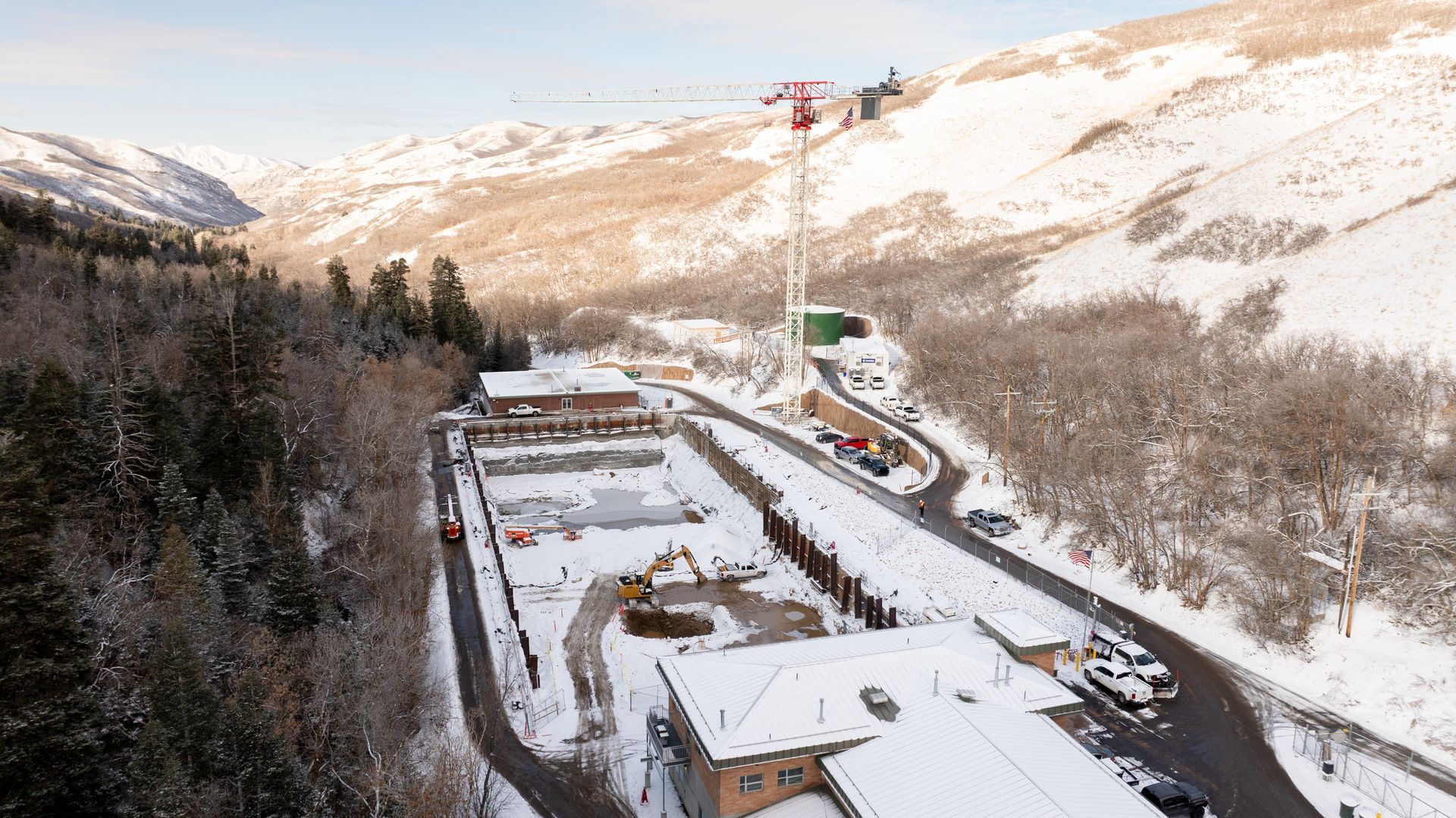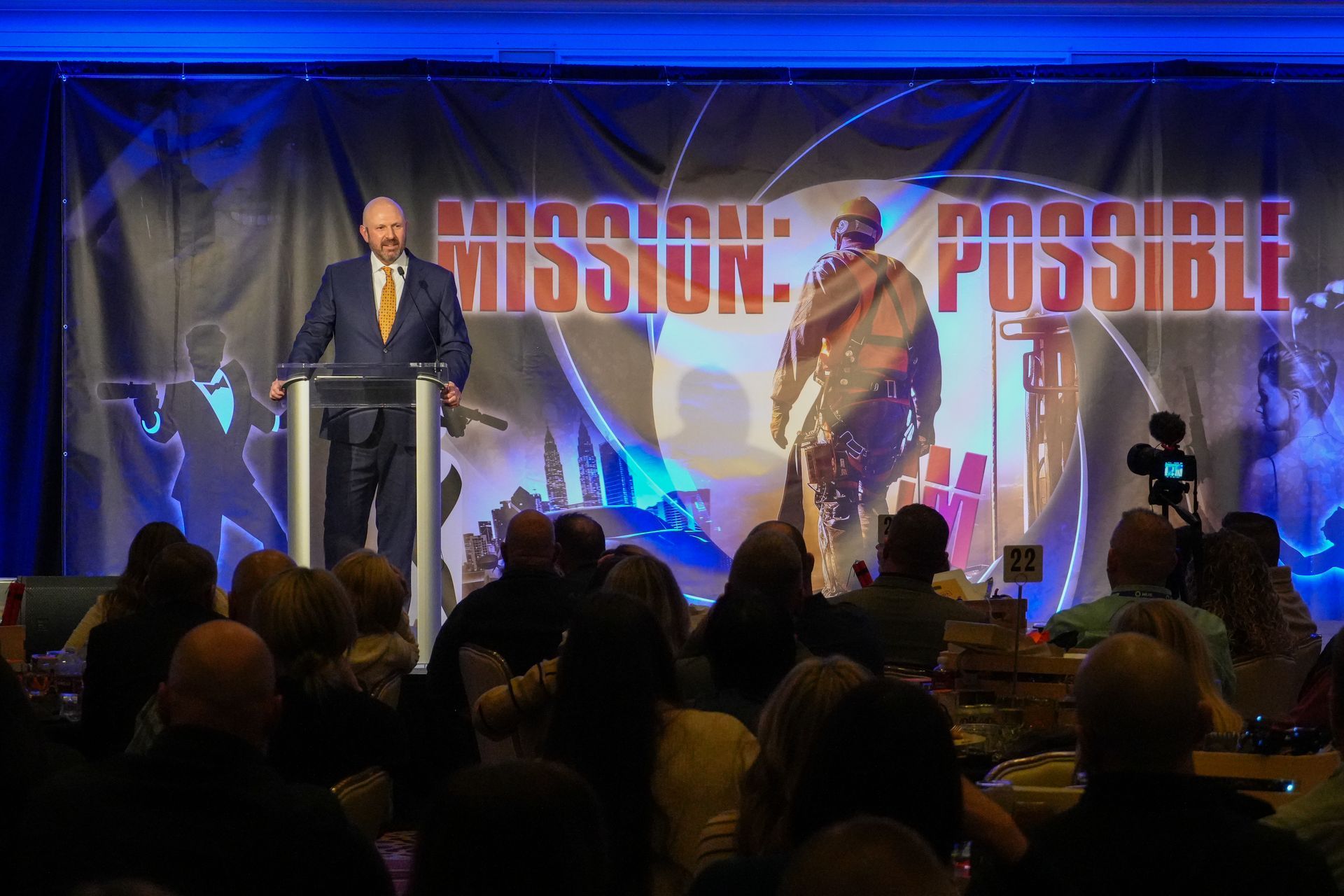Perfect Calling
The face of Utah's AGC chapter for four decades, Rich Thorn's positive impact on Utah's construction industry has been nothing short of legendary.
Capitalizing on his family’s good name—and his own gregarious, optimistic nature and personal charm—Rich Thorn has been among the most prominent advocates of Utah’s construction industry for more than 40 years.
As the President/CEO of the Associated General Contractors (AGC) of Utah, Thorn has been the proverbial face of the association since assuming the title of its top executive in October 1982—just before reaching 25 years of age. It has proven to be a role tailor-made to his
skills, education, and upbringing.
“Every day is a great day,” Thorn exclaimed during an early February phone call to discuss how he was feeling after AGC of Utah’s 100th-anniversary convention. Besides it being the coveted century mark in time, this year's event was particularly special to Thorn due to the remarkable turnout and energy level of those who attended.
“Our numbers [of attendees] were above those of pre-Covid numbers, and couple that with the companies who were sponsors, we were really happy with the turnout,” he said.
It was also significant in that it was his second-to-last AGC convention, as Thorn, 65, recently announced his retirement, effective at the end of the state’s legislative session in March 2023.
“I’d be less than honest if I didn’t feel some bit of nostalgia,” he said. “This is the next to last one; there is a lot of sentimental value, as I’ve been through a lot of these.”
Over the past couple of years, Thorn has been gradually handing over the reins of the chapter to long-time AGC of Utah Vice President Joey Gilbert, with Melissa Camp, Director of Finance and Administration, also filling a vital staff role. Gilbert and Camp were hired in 1997 and 2003, respectively, and have more than 40 years combined experience, yet are acutely aware it’s going to be challenging filling Thorn’s shoes.
“He’s the eternal optimist, liked by everyone,” said Gilbert, trying to sum up Thorn’s character in a few words. “He’s always upbeat and treats everyone like a best friend. I get that comment all the time.”
“I’ve been trying to convince him not to leave,” laughed Camp. “He cares—that’s the biggest thing. And cares not just professionally, but about your personal life. We’re calling this his ‘farewell tour.’ It’s hard for him 100% to step back, but he’s trying. He’s trying to take it all in and enjoy it.”
Ideal Upbringing included Construction and Politics
A native of Springville, a relatively small Utah town with a rich history of heavy/civil contractors, Thorn was born into a prominent construction family. Great-grandfather Ashel O. Thorn started Thorn Construction in the 1920s, with grandfather Paul Thorn (AGC of Utah President in 1947) and great-uncle Grant Thorn also running the firm for many years, before it closed in 1981.
His father, James (Jim) Thorn, worked at the company for many years as a laborer, heavy equipment operator, foreman, and superintendent/project manager. Fond memories from Rich’s youth include staying at motels during the summer in towns like Orderville in southern Utah and Delle in Utah’s west desert, while Jim managed paving jobs.
Thorn spent summers in high school and college working at Thorn Construction, learning how to operate loaders, dozers, and asphalt pavers—great hands-on experience of what happens in the field.
“For me, that’s always been helpful because I can relate to what that’s like,” he said. “I will never forget the guy wallowing in the mud, laying pipe, making it happen on the job site. That’s where the work gets done.”
One powerful early memory came via a job site visit with Grandpa Paul, on a day with rather inclement weather.
“It was a lousy, rainy, bad day,” Thorn recalled. “We pulled onto the job and Grandpa Paul was the executive. He was wearing brand new Florsheim shoes. He got out of the car and walked through the mud to shake the ‘Cat skinner’s hand. I will never forget that. He saw the value of the people he worked with, and that’s the term, he worked with them. The Thorn name meant a lot in the construction industry; our company had a good reputation.”
On the flip side, his mother, Karen, was perhaps even more influential on Thorn, given her vast political clout and lengthy career that included working for two U.S. Congressmen and two U.S. Senators for 35 combined years, in addition to serving on multiple community and political organizations. She was sharp, with an infectious smile and a keen ability to connect with people of all persuasions.
Karen’s career included working in Washington D.C., which uprooted the family from tiny Springville and had them living in the nation’s capital from 1961–1964, Thorn’s first three years in elementary school.
The experience was magical for young Rich, with “family field trips” most weekends to different historical U.S. sites. He’s been to D.C. dozens of times throughout his professional adult life. He cites D.C. as perhaps his favorite city.
“He’s his mother, through and through,” said Thorn’s wife of 43 years, Sherrie. “He’s got his dad’s [gift of gab] skills—he likes to talk—but he’s got his mom’s kindness. His mom was just genuine.”
Karen’s ties helped Thorn effectively navigate Utah’s political waters at an early age, and his 40 years of lobbying on Utah’s Capitol Hill has been consistent and effective, year after year. He’s been resigning from various labor and pension boards and other workforce and industry committees (upwards of 15-plus during peak years) while having Gilbert step in to fill the void.
“It’s all part of the plan,” Thorn said. “It’s flattering to be called by the Governor to serve on a board or as a chair of a committee. I feel obligated to serve and I’ll give it my best. It’s nice to have people ask for your opinion.”
Thorn remains engaged in this year’s legislative session, having been to Capitol Hill three times, and is reading legislation, giving input, and suggesting amendments while Gilbert is running point.
“I’m up there as his wingman,” said Thorn. “We talk every day. That’s part of the [transition] process. It’s been a bit of a learning curve for me to sit back.”
Family First
Thorn said the single greatest benefit of working for the AGC, for himself and Sherrie, was being able to comfortably raise their family of four children. They met at Dixie College in 1976—Thorn was on scholarship playing football and baseball—and married in June 1978.
In the fall of 1980, he got wind of a staff assistant position at AGC of Utah and was hired to work under Horace (Hod) Gunn on September 15. It proved to be a great fit, with Thorn’s construction background and jovial nature making him an instant asset to the association. When Gunn announced his retirement less than two years later, both Thorn and his wife felt he was ready to take over as AGC’s top executive. They weren’t sure the Executive Committee and Board of Directors felt the same way about a 25-year-old, but they were optimistic at his chances, nonetheless.
“We were hoping and praying he’d get it,” recalled Sherrie, “but he still had to compete with everyone else. He had an advantage because he had the [staff assistant] job for two years. He was a young buck, but he had the family name and he loved the job. He was a perfect fit.”
Thorn remembers interviewing with the search committee, including Walter Christiansen, Allen Young, John Tempest, and committee chair Ted Jacobsen. They told him, “We’re going to give a young guy a chance,” according to Thorn. “I believe the Thorn name and my mom’s political prowess neutralized the ‘He’s too young’ discussion. I knew a lot of [AGC] members on a first-name basis before I ever walked in the door. I also brought something they recognized—potential.”
He was named Executive Manager (later called Executive VP, then President/CEO in 2000) in October 1982 and poured his soul into the job. The construction industry was struggling at the time, with Utah and the US still reeling economically from the fallout after the Savings and Loan crisis.
“Life from September to January, they are so busy,” Sherrie said about convention prep. “It’s just nuts. It’s a lot of work for Rich, Melissa, Joey, and the staff. It’s crazy. That ends, and lobbying at the Capitol begins. Lobbying is not so bad now, but back in the day, Rich was (at the Capitol) morning, noon, and night.”
She credits Camp and Gilbert for their hard work and contributions to making the association better over the past two-plus decades. “Rich couldn’t have done it without them,” she said. “They are his right and left hand—they’re a team.”
Chips Off the ‘Ol Block
Thorn’s three sons—Cody, Brady, and Tyler—all ended up pursuing careers with ties to the construction industry, and speak glowingly of their father’s impact on their respective success.
“Everything I do has been by observing how my dad handles and treats people,” said Brady, Sr. Vice President at Murray-based Beehive Insurance. “As a result of that, my career has been very successful. I believe in the ‘Golden Rule’—you treat the janitor and the CEO with the same level of respect. People like it when they are appreciated and valued. I know my clients’ wives and friends, their victories and successes.”
“I was literally raised by the AGC,” said Tyler, Area Manager for Bridge Source. “I’ve attended conventions, conferences, and golf tournaments in a stroller, and now I attend those same functions with my wife, and we’ve taken our babies to conventions.”
Tyler continued, “From a son’s perspective, he has always been a selfless person. He was always available, always willing to help. You can tell that work meant a lot to him and he was good at it, but we were the top priority. He would move heaven and earth to go to anything we did—scout camps, baseball tournaments, everything. He’s available if I need to bounce an idea off him, but we always talk about other things …sports, politics. He’s well-rounded in that regard.”
“His support has been amazing with me starting a new company,” said Cody, who founded Thorn Milling & Construction in 2018. “I reached out to him many times if I was having a hard time with a particular project. He’s always told me to be calm and collected and keep your composure. People jump to conclusions way too quickly. Treat people the way you want to be treated, and surround yourself with people who will make you a better person.”
Cody added, “I’ve never seen dad lose his cool. Also, when it comes to his leadership role at AGC, people look up to him. They learn from him. When he speaks, he demands your attention. Plus, he’s a phenomenal listener.”
Thorn said he’s proud of his sons’ career accomplishments thus far, and also wanted to give a shout out to his daughter, Shelbie, and her husband, Chris Curtis. Shelbie and Chris are the proud parents of three children and reside in Salt Lake County. Shelbie said her father’s strong work ethic and ability to make friends are among his hallmarks, but “work was work, family came first.” As she got to be a teenager and hanging out with friends, her dad used to tell her “remember who you are. It’s just stuck with me. I’m a Thorn and we take pride in our name. I’m doing that now with my kids.”
A Legacy of Excellence
The AGC has long attracted the “best of the best” from Utah-based general contractors to lead the chapter, including company owners, presidents, CEOs, and other high-ranking executives that fill various executive committee and board of director positions annually.
So Thorn, needless to say, has worked with hundreds of talented, influential people over the years, spanning every type of construction—from general builders to highway and utility contractors, and everyone in between. Praise for his inclusive nature and effectiveness as the chapter’s long-time leader is found in spades.
“He’s an ‘A-game’ type of guy—and he does it with a smile on his face,” said Bob Tempest, former Vice President for Murray-based Tempest Enterprises, and a long-time advocate of AGC of Utah who served as Chair in 2011, and as a Lifetime Director for a decade.
“Rich has always demonstrated that he’s in the service of the industry,” said Tom Case, former Granite Construction executive and 2005 AGC of Utah Chair, who now operates TCM Services in Park City. “It’s through that service that he adds value to the members, and it’s why people keep coming back.”
Case, who also served as Director of the Highway/Transportation Division for AGC of America in 2014, said Thorn’s impact is recognized nationally by other chapters.
“I got to see other [AGC] chapters and how they do things, and I would say Utah is one of the best in the country, and that is a direct reflection on Rich, Joey, and the team.”
“To his fellow chapter executives, he is always willing to share what he and the Utah AGC does that is successful. At the same time, he’s not hesitant to listen and learn about what others are doing and bring that back to Utah,” said Ken Naquin, CEO of the AGC of Louisiana. “Rich has that innate sense of what makes an individual special and recognizes how to engage that talent. Rich has always positioned Utah AGC to be supportive of AGC of America—that is not easy to do.”
“I’m impressed with the network of people he cultivates and the relationships he maintains,” said Scott Parson, CEO of Staker Parson Materials & Construction of Ogden and 2022 AGC of Utah Vice Chair. “The construction industry is all about connection and relationships, and Rich epitomizes that.”
“Rich is one-of-a-kind and so focused on making our industry better,” said Rob Moore, Executive Chairman for Salt Lake-based Big-D Construction and 2010 AGC of Utah Chair. “He gets things done. He knows who to tap and who to talk to.”
“It’s easy to say good things about Rich,” said Doug Welling, former President/CEO of Jacobsen Construction of Salt Lake City and 2018 AGC of Utah Chair. “Rich has been interested, capable, invested, and energetic about our industry for many years. He never gets tired, never gets offended. He’s always at the forefront making things happen.”
Welling, who also took construction management courses at BYU with Thorn all those years ago, noted that a new slate of leaders is elected each year, and each person who serves as Chair has an agenda. Thorn’s ability to help new leaders maximize their calling is second to none.
Doug Watts, the former President/CEO of St. George-based Watts Construction and 2014 AGC of Utah Chair, expressed his appreciation for Thorn’s influence on his personal life.
“Rich came into my life at one of my darkest periods [...] and helped me believe I was still relevant,” said Watts. “He is generous, charitable, and never lets anyone down. He has been the best fit to lead the AGC of Utah […] and built it into a powerful, well-respected organization. He is a very good friend.”
“There are a lot of unique and wonderful things about Rich,” said Scott Okelberry, Executive Vice President and COO of Orem-based Clyde Companies, who served as 2021 AGC of Utah Chair. “As the President of this organization, he’s unmatched. We go to regional and national chapter leadership meetings and there are a lot of good leaders out there, but nobody stands above Rich Thorn. We’re fortunate in this industry to have a leader like him, somebody with his level of experience, his personality, his assertiveness, and his vision of this association. As he prepares to ride off into the sunset in just over a year, we have a very capable successor in Joey Gilbert, who is fully ready to take the reins.”
“It is difficult to imagine AGC and our Utah chapter without Rich,” said Stephen Sandherr, CEO of AGC of America. “He is such a tremendous force of nature, constantly plugging away at his job with his sunny disposition. He has definitely helped shape our association for the better, and is one of our better known and widely-respected chapter leaders. Filling his shoes won’t be easy, but if there is one thing we have learned about the AGC of Utah, there is no challenge too big for the chapter to overcome.”
Thorn was wistful in trying to sum up his AGC career.
“This has been a part of my genome for two-thirds of my life,” he said. “It’s filled with great memories. There will be some things I’ll miss. But I’ll look back and say we accomplished some pretty good things. I was the luckiest guy ever in that I got to do a job I absolutely loved.”


Despite some minor economic headwinds, Utah is poised for another solid, if semi-unspectacular, year of construction and real estate development, according to top economists locally and nationally. Indeed, 2025 is shaping up to be much like 2024, a year where firms across the A/E/C spectrum completed dozens of life-enhancing, community-uplifting projects across every major building sector—in other words, a lot of projects were built outside of the still churning multi-family market. These firms thrived for the most part, posting positive revenue growth and maintaining momentum in the face of the usual challenges of shallow labor pools and volatile material costs. Utah continues to rank among the top states nationally on key economic drivers such as population growth, construction employment, a pro-business climate, and a legislative body that continues to be bullish on funding higher education and transportation projects. Prospects are good with a can-do mentality among developers, municipalities, and the firms designing and building the jobs. "Utah will continue to have above average growth and is in great position to continue its great track record with a growing population, and a strong economy and construction market," said Ken Simonson, Chief Economist for the Associated General Contractors of America (AGCA) in Washington, D.C. "Utah has been on a steady, strong upward path with 27% growth in construction employment—three times the national average of 9%—since 2020." Simonson said Utah's construction employment growth doubled last year, up 6%, which is twice the U.S. average. Growth would be even stronger, he added, if contractors could find workers, particularly skilled tradesmen. Simonson said a survey of 1,500 firms nationally stated 94% had openings for craft workers. "It's hard to fill (skilled) positions, more difficult than last year," he added. Utah's consistent population growth—the Beehive State ranked fourth according to the U.S. Census from 2023-24 with 1.8% growth (3.44 million to 3.50 million)—is a driver of demand for so many types of construction, as well as a course of construction labor. Simonson said the state has been more welcoming of immigrants, an important source of labor for contractors across the board. Utahns also have a reputation for being well-educated coupled with a strong work ethic and drive to succeed, making the state an attractive place for new businesses looking to expand. Developers Waiting Out Interest Rates; Hope for a Drop in '25 The Fed kept interest rates where they are in January—a decision not popular with many real estate developers simply itching to invest capital and have projects waiting to cut loose the minute rates become more favorable. That pent-up demand could heat up the market if rates drop by even half a point, particularly in the multi-family arena. Simonson said multi-family was down nationally 8% from September 2023-24, with Utah seeing an equivalent slowdown, despite a huge amount of inventory that hit the market in 2024, including attractive high-end downtown properties like Camber, The Worthington, and Astra Tower, and many others along the greater Wasatch Front. "Reductions in the [Fed]’s short-term interest rate target will make financing a bit less expensive but developers still can't get loans or want to proceed if rents aren't high enough to cover the financing and construction costs, including time to complete if there are extended delivery times for electrical equipment such as transformers and switchgear," Simonson added. "Utah isn't immune from these challenges, but if the underlying population growth will be supportive of rent increases, that may bring back multi-family construction sooner than in areas that aren't growing as fast, or at all." Spendlove Keynote at 2025 NAIOP Symposium Senior Economist for Zions Bank, Robert Spendlove, said Utah is well-positioned to maintain solid economic activity, with factors of low unemployment (hovering around 4%), solid wage growth (3.9% in December), and more than a quarter million jobs added at the end of last year. "Utah had unexpected, continued strength in the labor market," said Spendlove at NAIOP Utah's 2025 Symposium in January. "If we could pause the economy and stay where we're at now, we'd be in a perfect position." Consumer inflation, he said, remains sticky at nearly 3%, with the Fed targeting 2% before they can lower interest rates. "Until it's at 2%, they can't claim victory," he said. Overall, consumer prices are up a whopping 22% since 2020. "It's a struggle for people—those prices are never going back down. Inflation is just adding to those price increases. [Fed Chair Jerome] Powell said they will not make the same mistake as the 70s; they will not cut rates until inflation is down." In addition to strong 1.65% [WHAT TYPE OF] growth and 1.8% employment growth, Utah rebounded quickly from the pandemic. "That shows the strength of Utah's economy and labor market," said Spendlove. He added that Utah's GDP was up 4.6%, indicating the strongest economic growth in the U.S., with consumer sentiment improving and greater small business optimism. Utah Maintains Steady Growth, Says Eskic The Beehive State's remarkably consistent and steady growth remains a major reason why its economic outlook remains rosy, said Dejan Eskic, Senior Research Fellow at the Kem C. Gardner Policy Institute at the University of Utah. "Utah's population growth has never dropped below zero since 1950—we're still increasing with net migration," said Eskic at an event hosted by the Intermountain Chapter of the American Concrete Institute in January, with growth slowing by only .08 to 1.65% "There is so much demand in our economy that even in a down year for housing, construction employment is up 6.2%," he said. "The American household, on average, has never looked better on paper when looking at financial stability," with 70% of household debt tied to mortgages. Living in Utah is still expensive, even though the state is now listed as the 10th most expensive state to live in, down from 8th. "It doesn't mean Utah is more affordable, other states are just more expensive." The housing crisis will remain among the biggest challenges, both with affordable housing and overall number of units that need to be built. Governor Spencer Cox has made his intentions known that communities need to prioritize ways to address all housing issues, with a desire to see tens of thousands of single family homes built in the next decade. Way easier said than done, simply because developers cannot be expected to be altruistic when market conditions are competitive and profit margins potentially volatile and risky. He expects rents to increase once absorption is reached. Other items of note: —Consumer Price Index dipped to 2.6%, where it is expected to stay. —Expect growth in wages and employment. —Commercial construction will be primarily flat, similar to the last two years. —Office is flat, medical and industrial markets will continue to grow; industrial may be dictated by international trade. —Utah expects to add 500,000 people in the next decade, and will need a jaw-dropping 275,000 more housing units in that time, primarily along the Wasatch Front. "We need to change the dialogue if we're going to solve the housing crisis," said Eskic. "Currently, 92% of renters are priced out of the market. Construction must be optimized."

July 23rd, 1847 was a pivotal day for the pioneers. Records from the time detailed how the advance party trekking into the Salt Lake Valley built a dam to convey water from City Creek to freshly plowed land. Years later, the city hired civil and hydraulic engineer Herman Schussler to design a system to bring water through laminated wood pipes to 20,000 Salt Lake City residents while preparing for future growth. Schussler said, in a presentation to Brigham Young in 1872, “I propose to construct the pipe system of the City of such dimensions as to be capable of supplying five million gallons per diem.” While those original pipes couldn’t make it to year two, the design was in place for cast iron pipes to go in their place in 1876. The 37 carloads of cast iron pipe, plumbing tools, water gates, and more came from multiple suppliers from eastern US industrial hubs of St. Louis, Boston, and Louisville, KY. Those collaborative efforts brought modern waterworks “in our lovely Deseret,” collecting water from 19.2 square miles of watershed that feeds the 14.5-mile-long City Creek stream. Modernity Fast forward nearly 150 years, past chlorination that arrived in the 1920s, past the first water treatment facility constructed in Utah, the City Creek Water Treatment Plant in 1953, past filter installation in 1966, and past the canyon reopening for recreational use in 1975—Salt Lake City needed a new treatment facility to keep clean water flowing. The Salt Lake City Department of Public Utilities (SLCDPU) partnered with engineering firm Brown and Caldwell in design in 2018 to envision and engineer something new to ensure resiliency and reliable water service to its customers. While the plant escaped any critical damage in the March 2020 earthquake, it was a reminder of the urgent need to create a new facility. Design and construction would work around a coterie of barriers and challenges—keeping operations ongoing while building on a challenging site three miles into the wilderness—to produce the future of water treatment for Salt Lake City.

The Associated General Contractors (AGC) of Utah successfully hosted its 103rd Annual Convention January 23-24 at Little America Hotel in downtown Salt Lake, a popular event that brought together A/E/C industry leaders, professionals, and stakeholders for two days of celebration, education, and networking. The convention highlights the outstanding achievements of Utah's construction industry and provides valuable insights into emerging trends shaping the economically impactful sector, along with the announcement of new chapter leaders and board members for the 2025 season. Brett Nielsen, President of Brigham City-based Whitaker Construction, who has served on the AGC of Utah board since 2017, most recently as National Governor, was installed as 2025 Chairman, taking over the reins of the venerable association from Slade Opheikens, President of Ogden-based R&O Construction. In addition, Nielsen is in line to become the first Utahn to serve as AGC of America President in 2030. "What an honor to be standing here, to be in front of a group of people I have the utmost respect for," said Nielsen at Friday night's Installation Banquet. "It's still surreal to me to be here and know that I'm getting the opportunity to work with a group of people that I'm so passionate about. This chapter is truly one of the finest chapters in all of America." Nielsen started as a Laborer at Whitaker Construction in 1992, gradually climbing the company ladder until taking over in 2021 as President of the powerhouse municipal/utility contractor, the first non-Whitaker to lead the firm. The firm cracked the $288 million mark in 2024 in annual revenues, a notable increase from $109 million in 2018. Nielsen's introduction to the AGC was unassuming, attending the packed annual summer golf tournament and then his first convention in the late '90s. "I saw it as more a networking opportunity, primarily with other Whitaker employees, vendors, and occasionally competitors," he said. His eyes were opened to AGC's real value when the chapter hosted a Young Constructors Forum in 2000, which is the predecessor to the Construction Leadership Committee (CLC). "I remember meeting other young contractors from throughout the country, and discussing the nuances of our markets, type of interstate pavements [this is when the original I-15 was constructed pre-Olympics], margins to the segment of construction, etc." he recalled. "I vividly remember a general contractor telling me their margin and how low it was compared to our underground utility segment, and I for the life of me couldn’t understand why a contractor would subject themselves to such headaches for such a low margin." In 2013, Nielsen became Chair of the Utility Infrastructure Committee for the Utah chapter and attended an AGC of America (AGCA) meeting in Phoenix later that year related to highway and utility contractor issues, something he called "an eye-opening experience." It was held at the posh Biltmore Resort and didn't know anybody. At the opening reception, he was standing alone when several individuals—including Toby Crow, AGC of South Dakota Chapter Executive, and his wife Liz—approached him to strike up conversation. They in turn introduced Nielsen to Scott Berry, who at the time was Director of AGC's National Utility Infrastructure Division, which led to dinner with long-time AGC CEO Steve Sandherr and several other AGC of America staff, along with fellow contractor members. "The rest is history," said Nielsen, who has been a member of the AGC of America Utility Infrastructure Division since then, including a stint from 2018-2020 on the AGCA Board. "I'm a relationship guy. They are important to me, and AGC provides the platform for me to collaborate with like-minded individuals to work on being informed, educating, and ultimately protecting not only our company the livelihoods of our employee-owners, but our industry. The benefits that AGC brings are real and measurable. AGC members are the 'Voice of the Construction Industry' both on the hill here in Utah, as well as in Washington, D.C. The issues that face our industry are complex, and those who want to exploit regulation, slow growth, and leverage legislative change to benefit their personal or industry interests cannot be overstated. We as contractors need a collective voice and for the Construction Industry, that voice is the AGC." Nielsen talked about the unique relationship that forms between AGC member firms, and how they work together for the good of the entire industry, despite competing against each other weekly to land new projects. "It makes me proud for what we accomplish here within this state," he said. "We come together, we solve tough problems related to our industry and we compete fiercely against one another." He mentioned competing that week head-to-head with Orem-based W.W. Clyde & Co., led by its President, Dustin Olson, on two sizable projects. Each team won a job, and subsequently lost a job. Said Nielsen: "I reached out to Dustin and congratulated him and told him it was a hell of a bid—he congratulated me as well [...] and followed up with the statement: 'If I'm going to lose to a contractor, I want it to be someone like you'. Many of us do that day-in and day-out. To be a part of a group that can accomplish what we accomplish, and then to turn around and be able to come to an event like this and celebrate all our hard work, is something that is astonishing to me." Nielsen said recruiting and retaining new skilled talent for the industry will be one of his top priorities this year and encouraged AGC firms to get involved with the Construction Leadership Committee (CLC). "I'm passionate about the future of people in our industry," he said. "I realize we're not the young spring chickens that we once were. It's our duty that we are setting the stage and making sure we're prepared to continue what we do. We all have great people who have gotten us where we're at today—we want to make sure we're bringing [new people] along." Nielsen closed his remarks by thanking his immediate family, including wife Hilary, daughter Emery, his mother, Shirley Harding, and mother-in-law, Ginny Butikofer, in addition to the Whitaker family and fellow co-workers.

Salt Lake City finally has the modern take on mountain living it has needed with Camber, the 422-unit multifamily project developed by Endeavor Real Estate Group, designed by Texas-based GFF Architects and built by Murray’s very own Zwick Construction. Camber’s neighborhood environment extends inside and out, bringing comfort on multiple levels. The commitment from the project team to lead on the multifamily front resulted in community over commodity with a luxury, mountain modern example of an apartment community.

Glittering in copper metal cladding and reflective glass, and towering in the capital city skyline, is The Worthington. Developed by Chicago-based Convexity and designed by SCB’s Chicago office, the Worthington stands tall and cracks the top 10 tallest structures in Utah. Ownership Marks the Spot But long before residents took a dip in The Worthington’s 12th-floor pool, Convexity saw an opportunity with both site and market, said Jessica Minton, the developer’s Senior Vice President. A high-rise on the eastern edge of downtown could offer spectacular views from above and afford residents walkability through the city below. Research from the firm included tours around the city to see what the market had in place, but crucially what it wanted. “Luxury high-rises are our niche. We knew we were capable of delivering a product that was successful in other markets,” said Minton. “And we knew it would succeed in Salt Lake City.” Construction was a joint partnership between Sandy-based Layton Construction, who helped to bring the local know-how, and Chicago-based high-rise building experts W.E O’Neill. The luxury amenities and high-quality residential finishes came from a project that looked toward accountability and collaboration in construction to take Worthington all the way up. Safety for Tenants, Public, and Builders Phased delivery, a newer process for Salt Lake City in high-rise construction, was an essential part of Convexity’s plans to bring the project to market. Minton praised the collaboration between Salt Lake City officials and the project team for “a smooth transition to get us to market.” “There’s a liability and a risk involved from the city to sign off on life safety measures while construction is ongoing,” she said. "It was a fully vetted and well-thought-out process from all of us—developer, city, and contractor— no party took this lightly." Phased delivery dictated that construction would turn over the first 16 floors for occupancy before moving on up to finish the rest. Rick Millward, Project Manager for Layton Construction, thanked Salt Lake City for being as forward-focused as the project team to ensure a high-quality building, namely helping to fine-tune solutions provided by the project team. He said the construction team was up to the challenge on multiple fronts to be a good neighbor and partner as they built. The give-and-take was brilliant as construction installed fire sprinkler systems throughout the structure instead of just completed residential floors, limited road closures to late night hours, and shifted pedestrians to a new walkway—simultaneously meeting city and construction goals. Millward said the team created a buffer zone of three completed floors as construction finished on floors 1-20 to keep construction noise from reaching the floors below. “You have to have residents come in and expect not to have to care about us at all,” said Millward. Minton added that the construction team’s commitment to an ironclad logistics plan created dedicated entrances and exits for workers and residents. “It needed to be a fully coordinated, daily effort,” she said. After all, “Residents aren’t moving into a construction site. There is no margin for error when people live there.” They went so far as to perform “concierge” duties to ensure residents only accessed specific elevators programmed to keep people from accidentally stumbling into active construction. Coordination between construction teams and apartment staff was seamless, actively informing residents 48 hours in advance on water and power shutoffs to keep people comfortable and in the know. With a busy street below, coordination kept pedestrians worry-free as they passed by. A covered and reinforced canopy sidewalk went in along 300 South, as Millward said, for the construction team to take full ownership of safety. Being a good neighbor paid off in more ways than one. Millward said Kathie Chadbourne, who runs From the Ground Up nearby, served coffee to the concrete truck drivers who worked through the night during the 13-hour foundation pour. Her work added to the buzz on site as the construction crew placed 3,600 yards of concrete foundation for the main structure. Three pump trucks took concrete from a cycling set of six trucks delivering slurry from “all of Geneva [Rock’s] concrete plants in the area” to help pour through the night. Millward says The Worthington isn’t going anywhere, especially with a super-stable matte footing that dips between 18 and 24 feet below street level.

Electrical contracting is competitive as hell. With a plethora of mega projects upcoming, a bidding war for the best electricians and estimators, and even a race to secure the energy to power Utah buildings, the competition at every level seems to grow more intense with each passing year. How can electrical contractors respond to upcoming trends and win work in the Beehive State? It Starts with Labor Ken Hoffman, Preconstruction Manager at Ludvik Electric, said that the competition for labor has been particularly fierce since he and his team began working on the New SLC International Airport some years ago. Competing for great people has always been the case, but the influx of high-level projects over the last decade, he recalled, “pulled everyone up” with drastic increases in wages that helped electricians bring more money home and brought in a cadre of workers from out of state to push jobs past the finish line. There is additional work to be done to bring in the next generation of fieldworkers to help build the state’s future, specifically the financial incentive to enter into a demanding, sometimes dangerous field. Contracting tech company ServiceTitan reports that salaries for entry-level electricians have risen 9.14% since the beginning of 2023, but is it enough? No, and it is hampering project execution. At a recent Urban Land Institute (ULI) Trends Conference, Hunt Electric CEO and President Troy Gregory offered a sobering statistic: currently, for every electrician who enters the trade, three electricians depart. Nathan Goodrich, Division Manager of Helix Electric, said that the industry needs to find solutions fast, as competing for the same people in a wage-based arms race is unsustainable. “We have to promote the trades as people are coming through high school,” he said. Exposure through industry days and other presentations is one way while granting release time for high school student workers was another that Goodrich mentioned as two ways to bring in the next generation of electrical contractors. Gregory agreed, saying that Hunt Electric and other industry groups have become much more involved at the high school level by showcasing and giving interested students career opportunities. He and his team have had success working on pre-apprenticeship that gives the most eager hands-on experience in prefabrication, an area that only grows in importance for contractors. “We’re getting them in a better position to be more productive on a job site on day one,” said Gregory.

Editor's note: UC+D's annual look at age 40 & Under A/E/C professionals includes individuals from a wide range of market segments including a general contractor VP, an interior designer, a rising UDOT director, a steel industry entrepreneur, an equipment dealer owner, and an electrical contractor safety/HR executive. Each holds a key position at their respective firm and has proven their skill and capability along their unique career paths.

Architect Brian Backe was succinct when he stated, "when I try to describe the Climate Innovation Center, one of the phrases is 'big things comes in small packages'." His words couldn't be more profound. An ambitious adaptive reuse project that is generating significant buzz in the sustainable building arena locally, Utah Clean Energy's new Climate Innovation Center (CIC) is the transformation of a modest, nearly 70-year-old, 3,000 SF single-level commercial structure into a state-of-the-art, two-story, zero-energy building that will serve as UCE's home for the next half century. "Within a 3,000 square foot footprint it has urban infill, is an adaptive reuse site, Net-Zero, combustion-free, hybrid mass timber structure—we really packed in a lot," said Backe, Principal-in-Charge for Blalock & Partners, who worked closely with Salt Lake-based Okland Construction to ensure optimum sustainability throughout the construction process. The $5.4 million, 5,260 SF project officially opened in June to much pomp and circumstance, and rightfully so. The center showcases the potential of what homes and buildings can be—spaces that are not only comfortable and inviting, but also produce zero pollution. The building will offer a space dedicated to learning, exploration and collaboration centered on climate solutions and improving local air quality, and a place for the community to engage and create solutions to the challenges we face. The project is a testament to CEO/Founder Sarah Wright and her team at Utah Clean Energy, and their commitment to increasing awareness of environmental sustainability. Their new home makes a bold, walk-the-walk statement about the importance of renewable energy in the built world. "There needs to be an education and understanding that renewables (solar, wind, hydro, geo-thermal) are our cheapest resources," said Wright, a Chicago-native whose diverse background includes work in geology, environmental consulting, air quality, and occupational health. She founded UCE, a mission-driven non-profit, in 2001 and is thrilled to see the CIC finally come to fruition after years of planning. The project, she said, embodies UCE's dedication to transforming Utah's built environment to be zero energy and emission-free, while helping the community reimagine the places we live and work. "This is a living laboratory and teaching tool for the public and the business community, demonstrating the tremendous role that buildings have in solving climate change," said Wright. "Everyone that's been here loves it and other owners say they are inspired by it." Kevin Emerson, Director of Building Decarbonization and an 18-year UCE veteran, said the project became a necessity in recent years as UCE's staff swelled to 15 people. "We've had a dream to really 'walk to talk' through our office headquarters and (CIC) is the result of that dream coming to fruition," said Emerson. "It is more than just office space—it's meant to be a showcase and teaching tool for the construction and design industry." "There is nothing more sustainable than reusing our existing buildings and breathing a new 50-year-life into a structure than was slated for demolition," said Backe, adding that construction crews seismically braced the primary existing CMU block wall, in addition to reusing over 65 tons of CMU and 50 tons of concrete.




















